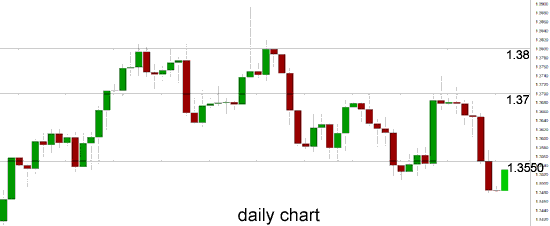The euro has done well in the last 24 hours to move off the support level around 1.35 and rally higher back towards 1.3550 which has been its only real movement higher for more than a week. To finish out last week the euro continued its decline and moved to a two month low touching below the support level at 1.35. The next obvious support level below is 1.34. For the last month or so the euro has generally steadied and established a trading range roughly between 1.3550 and the recent resistance level at 1.38, however to finish out a few weeks ago the euro broke down through the support level at 1.3550. The 1.3550 level has become a key level over recent times and a couple of weeks ago the euro sprung off it to a two week high at the resistance level at 1.37 where it has spent several days consolidating before dropping sharply back to the key 1.3550 level again. After placing some pressure on the resistance level at 1.38 several weeks ago, the euro has since fallen sharply down to its lowest level in two months.
Through November the euro enjoyed a solid move higher which saw it return to a wall of resistance at 1.38 and in doing so move to a then six week high. In the few days afterwards the euro challenged the 1.38 resistance level again before being turned away yet again. In mid November the euro did well to bounce strongly off support at 1.34 and recover the lost ground from the previous couple of days which saw it fall from the resistance level around 1.3550. This was after a few weeks which saw it move steadily higher from a support level at 1.33 back up to a three week high just above 1.3550. Over the last few months 1.3550 has been a key level.
Towards the end of October the euro enjoyed a strong surge higher to move through to its highest level in nearly two years just above 1.38 before spending that week content to consolidate around this level. Over the following three weeks it fell heavily down to a support level at 1.33 before recovering well. It moved quite well throughout the middle of October after breaking higher from its sideways range. For the month leading up to that, the euro traded within a narrow range between 1.3450 and 1.3650 before the range narrowed down to between 1.35 and 1.36. The former level of 1.35 was strongly tested a few weeks ago and has resurfaced as a significant level presently.
The pressure on the european Central Bank to cut interest rates again ratcheted up on Friday after figures showed inflation unexpectedly falling further below its target. Consumer price inflation in the 18-country eurozone fell to 0.7 percent in the year to January from 0.8 percent the previous month, the eurostat agency said. The decline was unexpected - the consensus for a rise to 0.9 percent - and reinforced fears that the eurozone is about to suffer a Japanese-style bout of deflation that would further hobble the stagnant recovery. Once prices start to fall, economies can become moribund as consumers delay purchases in the hope of getting bargains later and businesses postpone investment and innovations. The ECB holds its monthly meeting Thursday and a growing number of economists think it may ease monetary policy soon in response to these deflation fears. The ECB targets inflation at just below 2 percent. The U.S. Federal Reserve, by contrast, also monitors unemployment.
 EUR/USD Daily Chart" title="EUR/USD Daily Chart" width="550" height="226">
EUR/USD Daily Chart" title="EUR/USD Daily Chart" width="550" height="226"> EUR/USD 4 Hour Chart" title="EUR/USD 4 Hour Chart" width="550" height="231">
EUR/USD 4 Hour Chart" title="EUR/USD 4 Hour Chart" width="550" height="231">
EUR/USD February 3 at 21:40 GMT 1.3530 H:1.3535 L: 1.3476
EUR/USD Technical:
| S3 | S2 | S1 | R1 | R2 | R3 |
| 1.3500 | 1.3400 | --- | 1.3700 | 1.3800 | --- |
During the early hours of the Asian trading session on Tuesday, the euro is continuing to rally higher after recently bouncing off support around 1.35 and it is trying to return back to 1.3550. Current range: just below 1.3550 around 1.3530.
Further levels in both directions:
• Below: 1.3500 and 1.3400.
• Above: 1.3700 and 1.3800.
OANDA’s Open Position Ratios
![]()
(Shows the ratio of long vs. short positions held for the EUR/USD among all OANDA clients. The left percentage (blue) shows long positions; the right percentage (orange) shows short positions.)
The EUR/USD long position ratio has moved back above 40% as the euro has dropped sharply back down to 1.3500. The trader sentiment remains in favour of short positions.
Economic Releases
- 03:30 AU RBA - Overnight Rate (Feb)
- 09:30 UK CIPS/Markit Construction PMI (Jan)
- 10:00 EU PPI (Dec)
- 15:00 US Factory Orders (Dec)
- 15:00 US IBD Consumer Optimism (Feb)
*All release times are GMT
